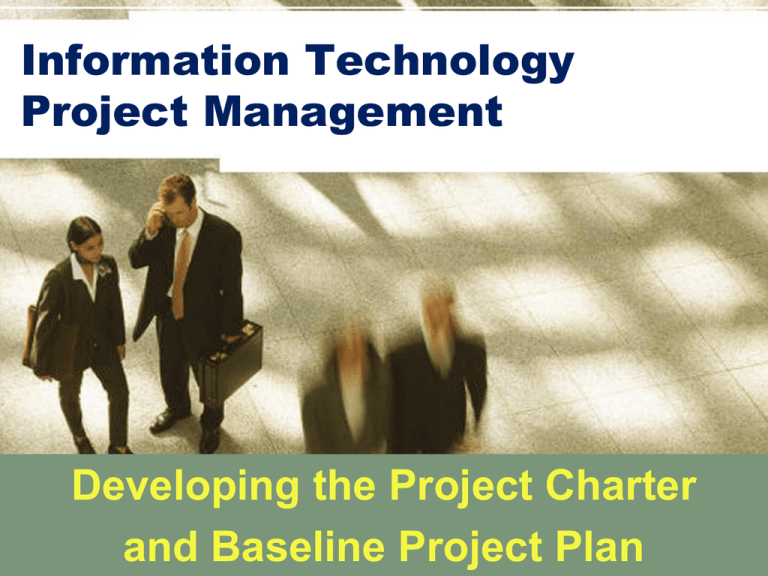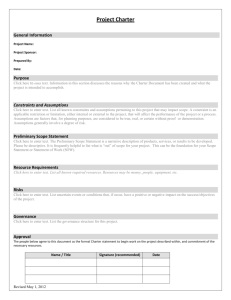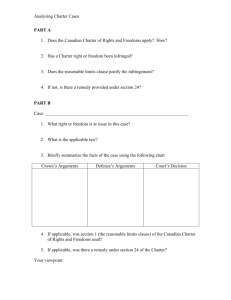Develop the project management plan
advertisement

Information Technology Project Management Developing the Project Charter and Baseline Project Plan 1-1 Contact: • • • • • Phone : 0815 8500 7800 Email : barokah.widodo@gmail.com Bbm : 24278CE4 Yahoomsgr : barokahw Facebook : barokahw My Background… Education • 2001- 2003, Master of Business Administration College of Business, University of Illinois at UrbanaChampaign, IL, USA • 1993-1998, BS in Computer Science Faculty of Computer Science, Universitas Indonesia, Jakarta, Indonesia My Background… Professional Experience • have over 15 years of continuous and progressive experience in the area of Business Development, System Integration, IT Management and Software/Information Engineering, with responsible positions as an IT Manager, Project Manager, Sr. Business Analyst and Design, Technical Architect, and Developer. And now .. a lecturer at MM UGM and Fasilkom UI .. An Advisor for Indonesian National ICT Council • Expertise in project management, applications development & maintenance, full life cycle development, Data Modeling (Logical and Physical Design of distributed Databases), writing and debugging complex stored procedures/triggers, SQL Server Database Creation, Backup and Recovery, Performance Issues, Handling errors, Troubleshooting network and database problems. Teaching Philosophy: Graduate education includes the discussion, dissection and critique of different ideas and concepts. It is a two-way interaction of an active, dynamic process of dialogue among students and lecturers. For this to be successful and promote interactive learning, two things are required. First, it is expected that all parties will come to class being fully prepared for all readings, case presentations, or other special assignments. Second, this active learning environment requires a willingness among all to engage in classroom discussion. Therefore, all students will be expected to share your valuable comments with me and the rest of the class. Professional Conduct: All students are expected to conduct themselves professionally. This means that behavior that would not be tolerated in a business meeting will not be tolerated in this classroom. All students start the semester with a 100% for the professional conduct grade. Points will be deducted for such behavior as repeated tardiness, walking out in the middle of class (emergency situations exempt), eating in class, irrelevant talking in class, any disruptive behavior 1-6 Professional Conduct: Using laptops or PDAs in class to legitimately take notes or work on class activities and projects is allowed, but all other use of laptops or PDAs in class is prohibited: (example: to check e-mail and news, talk/chat to friends, instant message, play on-line games, facebooking, etc). The use of hand-held and hands-free cellular telephones is prohibited. Please turn off any cellular telephones before entering the classroom. If you answer a cellular telephone during class, you will be asked to leave and not return during that class period and your professional conduct grade will be lowered significantly. 1-7 An IT Project Methodology 1-8 Advantages of Using Formal Project Management • Better control of financial, physical, and human resources • Improved customer relations • Shorter development times • Lower costs • Higher quality and increased reliability • Higher profit margins • Improved productivity • Better internal coordination • Higher worker morale (less stress) 9 Objectives • Describe the five project management processes and how they support each phase of the project life cycle. • Define the project management knowledge area called project integration management and describe its role in project plan development, project plan execution, and overall change control. • Develop a project charter and describe its relationship to the project plan. • Identify the steps in the project planning framework introduced in this chapter and describe how this framework links the project’s measurable organizational value (MOV) to the project’s scope, schedule, and budget. 1-10 Information Systems Planning Process Information Systems Planning Process What’s the goal and value of the IS projects to the organization? It requires important transition from a strategic mindset to a more tactical one How should we do it? The project charter + detailed project plan = the project’s tactical plan Project Management Processes Project vs. Product Management processes Project Management Processes and ITPM Phases 1-14 Project Management Process Project Management Process Groups: – Initiating – Planning – Executing – Controlling A business case recommendation – Closing Contract and administrative closure Project Charter and Plan the product-oriented processes measurement progress of the project’s goal 1-15 Project Integration Management The Key to Overall Project Success: Good Project Integration Management • Project managers must coordinate all of the other knowledge areas throughout a project’s life cycle • Many new project managers have trouble looking at the “big picture” and want to focus on too many details • Project integration management is not the same thing as software integration 17 Project Integration Management 1-18 Project Integration Management Processes • Develop the project charter: working with stakeholders to create the document that formally authorizes a project—the charter • Develop the preliminary project scope statement: working with stakeholders, especially users of the project’s products, services, or results, to develop the high-level scope requirements and create a preliminary project scope statement • Develop the project management plan: coordinating all planning efforts to create a consistent, coherent document—the project management plan 19 Project Integration Management Processes • Direct and manage project execution: carrying out the project management plan by performing the activities included in it • Monitor and control the project work: overseeing project work to meet the performance objectives of the project • • Perform integrated change control: coordinating changes that affect the project’s deliverables and organizational process assets Close the project: finalizing all project activities to formally close the project 20 Project Integration Management Processes 21 Project Integration Management Summary 22 What Went Wrong? • The Airbus A380 megajet project was two years behind schedule in Oct. 2006, causing Airbus’ parent company to face an expected loss of $6.1 billion over the next four years • The project suffered from severe integration management problems, or “integration disintegration... Early this year, when pre-assembled bundles containing hundreds of miles of cabin wiring were delivered from a German factory to the assembly line in France, workers discovered that the bundles, called harnesses, didn't fit properly into the plane. Assembly slowed to a near-standstill, as workers tried to pull the bundles apart and re-thread them through the fuselage. Now Airbus will have to go back to the drawing board and redesign the wiring system.”* *Matlack, Carol. “First, Blame the Software,” BusinessWeek Online (October 5, 2006). 23 Project Charters • After deciding what project to work on, it is important to let the rest of the organization know • A project charter is a document that formally recognizes the existence of a project and provides direction on the project’s objectives and management • Key project stakeholders should sign a project charter to acknowledge agreement on the need and intent of the project; a signed charter is a key output of project integration management 24 Developing the Project Charter The project charter and baseline project plan provide a tactical plan for executing the IT project. • • • • • • Project Approach Technical Approach Development Approach Application Approach Operations Approach Change Management Approach Purpose of the Project Charter • • • • • • Document the project MOV Define project infrastructure Summarize details of project plan Define roles and responsibilities Show explicit commitment to project Set out project control mechanisms 1-26 What Should be in a Project Charter? • • • • • • • • • Project Identification Project Stakeholders Project Description Measurable Organizational Value (MOV) Project Scope Project Schedule Project Budget Quality Issues Resources 1-27 What Should be in a Project Charter? – cont’d. • • • • • Assumptions and Risks Project Administration Acceptance and Approval References Terminology 1-28 Project Charter Template 1-29 Project Planning Framework 1-30 Preliminary Scope Statements • A scope statement is a document used to develop and confirm a common understanding of the project scope • It’s important for preventing scope creep – The tendency for project scope to keep getting bigger • It’s good practice to develop a preliminary or initial scope statement during project initiation and a more detailed scope statement as the project progresses 31 What the Winners Do “The winners clearly spell out what needs to be done in a project, by whom, when, and how. For this they use an integrated toolbox, including PM tools, methods, and techniques…If a scheduling template is developed and used over and over, it becomes a repeatable action that leads to higher productivity and lower uncertainty. Sure, using scheduling templates is neither a breakthrough nor a feat. But laggards exhibited almost no use of the templates. Rather, in constructing schedules their project managers started with a clean sheet, a clear waste of time.”* *Milosevic, Dragan and Ozbay. “Delivering Projects: What the Winners Do.” Proceedings of the Project Management Institute Annual Seminars & Symposium (November 2001). 32 Project Planning Framework The main purpose of project planning is to guide execution • The MOV • Define the Project’s Scope – – – – – Initiation Planning Definition Verification Change Control 1-33 Project Planning Framework – cont’d. • Subdivide the Project (WBS) into Phases to reduce complexity and risk • Tasks-Sequence, Resources, and Time Estimates – Sequence (linear vs parallel) – Resources required (technology, facilities, and people) – Time-to-complate estimated (more time = more costs) • Schedule and Budget-The Baseline Plan 1-34 A Sample of Project Baseline Gantt Chart An output of this framework is the detailed project plan that will serve as a benchmark and gauge the project’s progress Project Management Plans • A project management plan is a document used to coordinate all project planning documents and help guide a project’s execution and control • Plans created in the other knowledge areas are subsidiary parts of the overall project management plan 36 Common Elements of a Project Management Plan • Introduction or overview of the project • Description of how the project is organized • Management and technical processes used on the project • Work to be done, schedule, and budget information 37 Sample Contents for a Software Project Management Plan The Kick-Off Meeting • • • • • • Officially starts the work on the project Brings closure to the planning phase Communicates to all what the project is about Energizes stakeholders Engenders positive attitudes A sample: Kickoffmeeting.doc 1-39






